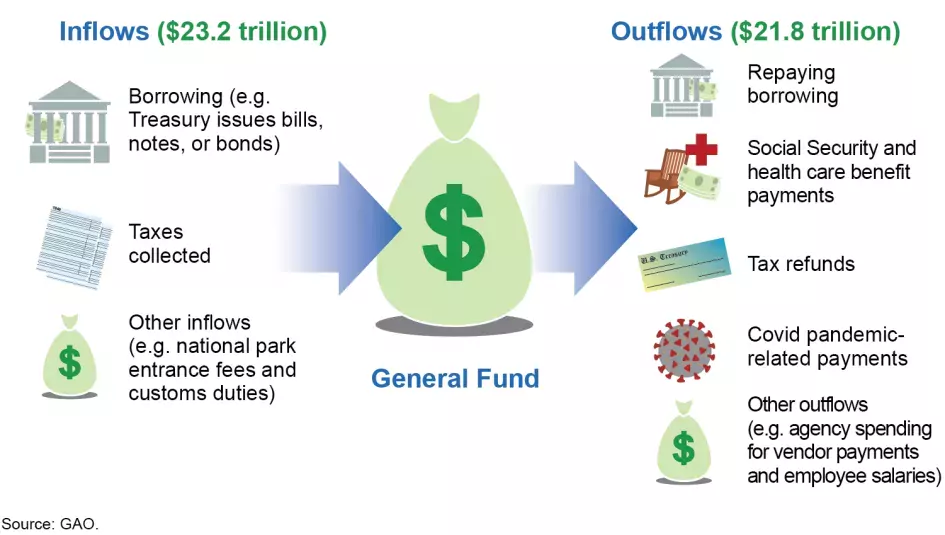The U.S. General Fund – “America’s Checkbook”
When you make a deposit to or withdraw cash from an ATM, your bank adjusts your account accordingly and provides your account balance. Similarly, the U.S. General Fund performs this function for the federal government—reflecting the cash activity for all federal entities. However, balancing “America’s Checkbook,” is a challenging yet critical responsibility.
Today’s WatchBlog post looks at the fiscal year (FY) 2020 Schedules of the General Fund, and some of the challenges in auditing the schedules.
The Schedules of the General Fund
The Schedules of the General Fund reports activity and balances, and includes components like cash inflows (deposits) and outflows (withdrawals). They also include other important financial metrics, such as the U.S. budget deficit. Our report provides the results of our audit of these schedules.
Inflows and outflows reported by the General Fund in FY 2020
Image

The federal response to COVID-19 significantly increased the cash activity and budget deficit reported by the General Fund in FY 2020. Some cash activity does not impact the deficit and some non-cash activity does impact the deficit. For example, most of the cash activity relates to borrowing (about $19 trillion) and repayment (about $15 trillion), which do not affect the federal budget deficit. The General Fund inflows and outflows that affect the deficit resulted in a $3.1 trillion budget deficit—the largest recorded federal deficit in history.
We audited the General Fund. What did we find?
As federal government auditors, our job is to determine whether the cash activity and related account balances reported by the General Fund are reliable. When we audited the FY 2020 Schedules of the General Fund, we were unable to provide an opinion (referred to by auditors and other professionals as a “disclaimer of opinion”). This means that the schedules were not auditable and the amounts reported may not be reliable.
What is one important ongoing challenge?
One limitation, among several we identified, relates to the fact that transactions are not easily tracked in enough detail as they are processed through the various General Fund information technology (IT) systems. This means that as auditors, we are unable to determine if they were properly recorded in the Schedules of the General Fund. This is mainly because many transactions are summarized and recorded as a group total instead of individually and detail transactions cannot readily be traced to the General Fund schedules.
Does this mean cash is unaccounted for?
No. Using the bank account analogy, this would be similar to your bank statement only showing a total withdrawal amount of $1,000 instead of the details of purchasing a computer (a withdrawal of $1,500) and returning a monitor you previously purchased (a deposit of $500). This net total withdrawal amount of $1,000, although accurate, decreases the amount of detailed information that you might receive from your bank. For the General Fund, the summarized amounts do not provide enough detail for an auditor to determine whether the schedules are reliable.
One possible way to solve this limitation is that the Department of the Treasury’s Bureau of Fiscal Service (Fiscal Service)—which manages the General Fund—could tag each transaction with a unique identifier that remains the same as the transaction passes through multiple systems (e.g. from start to finish). This could help Fiscal Service determine the effect of a transaction on all applicable accounts of the Schedules of the General Fund, including the budget deficit.
What progress has been made?
Since we first identified this limitation in 2018, Fiscal Service began developing ways of getting the information needed to track transactions in greater detail. Resolving this limitation is a multiyear effort. It requires coordination with federal entities as they may need to upgrade their processes or accounting systems in order to provide the additional information needed to the General Fund.
Why is the audit of the General Fund so important?
The information from the General Fund flows to the U.S. government’s Consolidated Financial Statements, which we also audit. The limitations identified for the General Fund affects our ability to issue an opinion on the government’s financial statements. Therefore, resolving the General Fund’s weaknesses is important to the financial reporting of the federal government as a whole. High quality financial information can also help policymakers in decision making, and keeps federal agencies and the government as a whole accountable.
- Questions on the content of this post? Contact the WatchBlog team at blog@gao.gov.
GAO Contacts
Related Products

GAO's mission is to provide Congress with fact-based, nonpartisan information that can help improve federal government performance and ensure accountability for the benefit of the American people. GAO launched its WatchBlog in January, 2014, as part of its continuing effort to reach its audiences—Congress and the American people—where they are currently looking for information.
The blog format allows GAO to provide a little more context about its work than it can offer on its other social media platforms. Posts will tie GAO work to current events and the news; show how GAO’s work is affecting agencies or legislation; highlight reports, testimonies, and issue areas where GAO does work; and provide information about GAO itself, among other things.
Please send any feedback on GAO's WatchBlog to blog@gao.gov.




